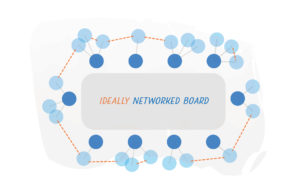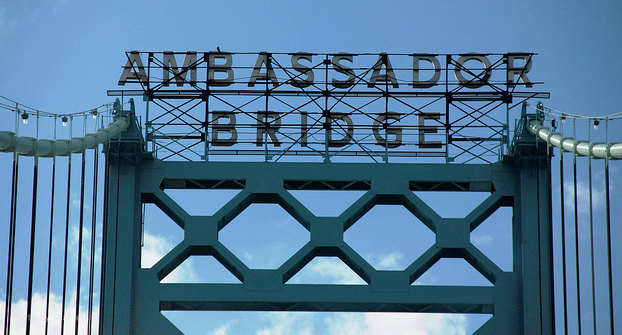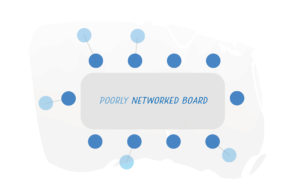Your non-profit’s board members diligently show up at monthly meetings. They are interested in the work of the organization and engaged in the issues around the board table. But do board members have a role outside of board meetings in building bridges to the wider community? If so what does this look like?
Where there is talk of board members as “ambassadors” it typically focuses on board members utilizing their personal and professional networks for fundraising. This post explores the idea that individually and collectively board members have a different outreach role to play, one complimentary to that of staff. Indeed, there are important dimensions of board member power that often go untapped. So encouraging board members to see themselves as ambassadors, and act as ambassadors can be quite beneficial,
I will also suggest that there are some “baby steps” board members can take to move from keeping their personal passion and board service a secret, which many do, to using it to quietly build a few external bridges to the community. I will also offer a tool to help boards get started on ambassadorship.
Leading with Intent
Board members show up primarily to lend their advice to the organization. Rightfully so. Their efforts are usually focused inward. According to BoardSource, a well-respected authority in the U.S.A on non-profit boards,
Board members are uniquely positioned to be successful advocates and ambassadors for their missions. As business leaders, community volunteers, philanthropists, and opinion leaders, they have the connections, the confidence, the respect needed to speak up on behalf of their organizations when policy decisions are being made that might affect the organization’s ability to achieve its mission.((BoardSource, Fundamental Topics of Nonprofit Board Service, Advocacy and Ambassadorship)),
According to BoardSource’s latest study Leading with Intent: 2017 National Index of Nonprofit Board Practices — only 52 percent of U.S organizations report that their board members are actively involved in advocating for their missions, and in many organizations board members do not advocate at all.
The role of board members in public policy advocacy, the more activist dimension of leadership, is another level of ambassadorship. It will be a topic for a future post. But read on…
Networked Boards
Much has been written about networked non-profits and the value of organization to organization connections in addressing system-wide problems.((See Beth Kanter (2012) Becoming a Networked Nonprofit, and Jane Wei-Skillern and Sonia Marciano (2008), The Networked Nonprofit, both published in The Stanford Social Innovation Review)) There has been little written about board member networks, even within the same board. There is at one exception.
Brent Never, a professor at the University of Missouri, has written about the importance of board member connections as a factor in fundraising.((See Never’s 2013 piece, Boards As Bridges in the Nonprofit Quarterly and the earlier paper Brent Never, Erin Nemenoff, and Jim Doyle, The Use of Organizational Champions: Boards as Bridges to Resources -University of Missouri – Kansas City, 2011. Paper presented at ARNOVA, Toronto, November 2011)) Some organizations, depending on the nature of their work and their funding environment, need stronger external board networks than others.
Brent has studied board member ties in a number of different kinds of organizations, the strength of the ties and whether the ties are cohesive (contacts who are known to each other) and redundant (ties to more than one board member). He depicts an “ideally networked” board like this:

Never’s research has shown that board member networks are often untapped even in the service of building community awareness of the important work of their organization. He too has found cases of organizations with board members who apparently have ignored their external contacts, who effectively govern in secret. In effect their connections in the community are kept separate from the work of the organization. They look more like this:
Creating bridges between board members and donors is topic best explored in conversations about fundraising.((Many non-profit boards, including those that oversee the provision of social services, play little or no role in fundraising. Where charitable donations, what many would associate with fundraising, play a big role, the work is often done by staff. A conversation about building board bridges to donors, especially if it is a new conversation for your non-profit, is probably one that requires the input of some expertise. Contact the Canadian Association of Fundraising Professionals (AFP) that has chapters in every province. The executive director of your local hospital foundation is likely a member)) It is not the focus here.
Using Contacts
Ambassadorship involves making use of your contacts. Joan Garry, a U.S. board consultant, has written about why board members seem so reluctant to identify whom they know. In a funny and poignant 2017 post entitled “A Fool Proof Way To Get Board Members to Open Their Rolodex” she suggests that the mere question of asking about who board members know causes them to “clam up”. Seemingly they forget the names of their friends.
Joan says that when board members are asked only to identify a few of their contacts they hear a more paralyzing kind of query. The question becomes, in my words, “who do you know that we can pester to give money or to volunteer”. I would add that board members might also hear “we want you to reveal the people who share your beliefs about the importance of what we do”.
Garry, as part of her post, offers a board tool one can download to help board members think about their contacts. It stimulates one to start by considering ones different social and professional contexts. I am going to do the same below, but with a tool that is less about identifying donor prospects.
Is There a Risk?
The idea of board members as ambassadors may raise a concern for executive directors. “What will happen if my board members are talking to people in the community about us? What might they say?”
Most boards make it clear, frequently in policy and/or board member agreements, that directors ought not speak “for” the organization. This role, especially where the news media is concerned is normally reserved for the executive director and/or the board chair.
It surely makes sense for there to be clear policy on who speaks when the media calls or when there is a controversy or issue in the news. This is even more important today where board members are active on social media in other aspects of their lives.((The subject of social media and governance, including he need to establish boundaries for board members is well outlined in a 2019 Board Source publication Social Media and Governance: Using it to Advance Your Mission))
Unfortunately even a modest approach to ambassadorship is inhibited by the fact that boards seldom talk about their organization’s mission or vision or, if they provide social services for example, the challenges their clients face. Talking about the important work of their organizations or the issues facing their community hardly seems risky. Is this really why non-profit governance is so often kept under wraps? I think not. The reason is that governance conversations seldom turn a board’s gaze outward or suggest that board members should “get out more”.((The notion that board members should “get out more”, was first presented to me by Terrie Temkin, a U.S. board consultant. The idea is explored in this 2013 GoverningGood post))
The Power of Board Members
Given the attention in today’s media to “influencers” one might be forgiven for thinking that board members, unless they are well known leaders in the wider community, are without power away from the board table. I think this is mistaken.
All board members can bring to every external encounter, the ability to leave a positive impression of themselves, the cause and the organization on whose board they sit. Board members, certainly those volunteering with the social sector organizations, tend to be regarded as:
- Genuine
- Altruistic
- Public service minded
- Reflective of the “average” person in their community
The concern that board members are not knowledgeable enough about what their organizations do to make themselves more visible is misplaced. Expertise is not the capital ambassadors bring to social gatherings or key stakeholder meetings. A board member’s mere presence can be influential.
Greater Community Awareness
For the organization and its cause, spreading the word is community education and free publicity. If five board members each have a conversation with two friends or colleagues, and each of those 10 people talk to two others, word spreads.
Also, If the five board members engage in a little listening as well as explaining then they may gather a little more community “intelligence” than they might otherwise of had. This can help directors in growing their own context for board leadership.
Board ambassadorship may be more important to some organizations than others. I am thinking of non-profits that may tend to be somewhat invisible to many in the community. This might include:
- Adult literacy programs
- Agencies that supports persons with disabilities
- Homeless shelters
- Transition houses for women and children
- Seniors services
- Youth serving agencies
- Addiction programs
- Community centres
- Local museums
The benefit of networking is not just cause related either. It can bolster a board member’s own status even if that is not a motivating factor.((The personal and professional benefits of non-profit board service are well described in Alice Korngold’s 2018 Board Leadership Study, a review of which is found here)) There is value too in raising the visibility and stature of volunteer board service.
Standing Up
It is generally assumed that board member’s will “stand up for” their non-profit and its cause. Since their involvement is consistent with their worldview, one would assume that their board service finds it way into some of their conversations.
For board members, what does is mean, standing up? Two things certainly:
- Correcting others’ misconceptions of the kind of work the organization does or the organization itself
- Initiating a conversation about the work of the organization on whose board they sit, or else adding particulars of this experience to an existing conversation.
Standing up does not mean, “speaking for” the organization. It may mean, speaking “about” their organization and even more likely, speaking “about” the cause.
Standing up can also mean, “standing up to”. The Merriam Webster dictionary says this means. “to meet fairly and fully” or “to face boldly”. As previously mentioned, a more forceful form of ambassadorship will be taken up in a future post on board members as advocates.
Getting Started on Ambassadorship
If you are interested in beginning to explore the outreach role of board members my Board Ambassador Exercise might get you started. I credit Joan Garry’s piece, referred to above, for its inspiration.
The exercise asks about a board member’s online profile and who in their own networks they may have or could talk to with about the work of their non-profit. A page only, it is primarily a tool for personal reflection exercise. However, it includes a suggestion about how to use it to initiate a board discussion.
One of the things I like about going down the board ambassador road is that not every board member has to be on the trip. If half your board members have had, or feel comfortable having, a mission-related conversation with one or more of their friends that’s great.
Most people like talking about important things. This includes board members. As caring humans we want to be connecting hearts and minds amongst family, friends and colleagues. Perhaps the Board Ambassador Exercise will generate both a needed conversation around the board table and a number smaller ones away from the table.
~ Note on the Image ~
The image chosen is of a portion of the Ambassador Bridge that connects Detroit, Michigan, U.S.A and Windsor, Ontario, Canada. This link is arguably one of the most important in the world, certainly from a commercial trade perspective.
The bridge over the Detroit River is the busiest border crossing between the the two countries. Daily traffic is in the range of 10,000 trucks and 4,000 automobiles. It is a toll bridge and is privately owned by the Detroit International Bridge Co, which is controlled by billionaire Manuel Moroun.
A $5.7 billion second bridge, the Gordie Howe International Bridge, proposed by the State of Michigan and the Government of Ontario, is now under construction. It has encountered both legal and political opposition, principally from owners of the Ambassador Bridge. The second bridge is expected to be completed in 2024.


